Strategic Management & Sustainability: AstraZeneca Case Study
VerifiedAdded on 2023/06/18
|11
|3460
|137
Report
AI Summary
This report provides a comprehensive analysis of strategic management and sustainability, focusing on AstraZeneca. It employs various frameworks, including PESTLE analysis to assess political, economic, social, technological, legal, and environmental factors impacting the company. The industry life cycle is examined, outlining the introduction, growth, maturity, and decline stages. A SWOT analysis identifies AstraZeneca's strengths, weaknesses, opportunities, and threats, while Porter's five forces model evaluates the competitive rivalry, buyer power, supplier power, threat of new entrants, and threat of substitute products. The report concludes with a strategic group analysis, offering insights into AstraZeneca's competitive positioning within the pharmaceutical industry. Desklib is a platform where you can find similar solved assignments and study resources.
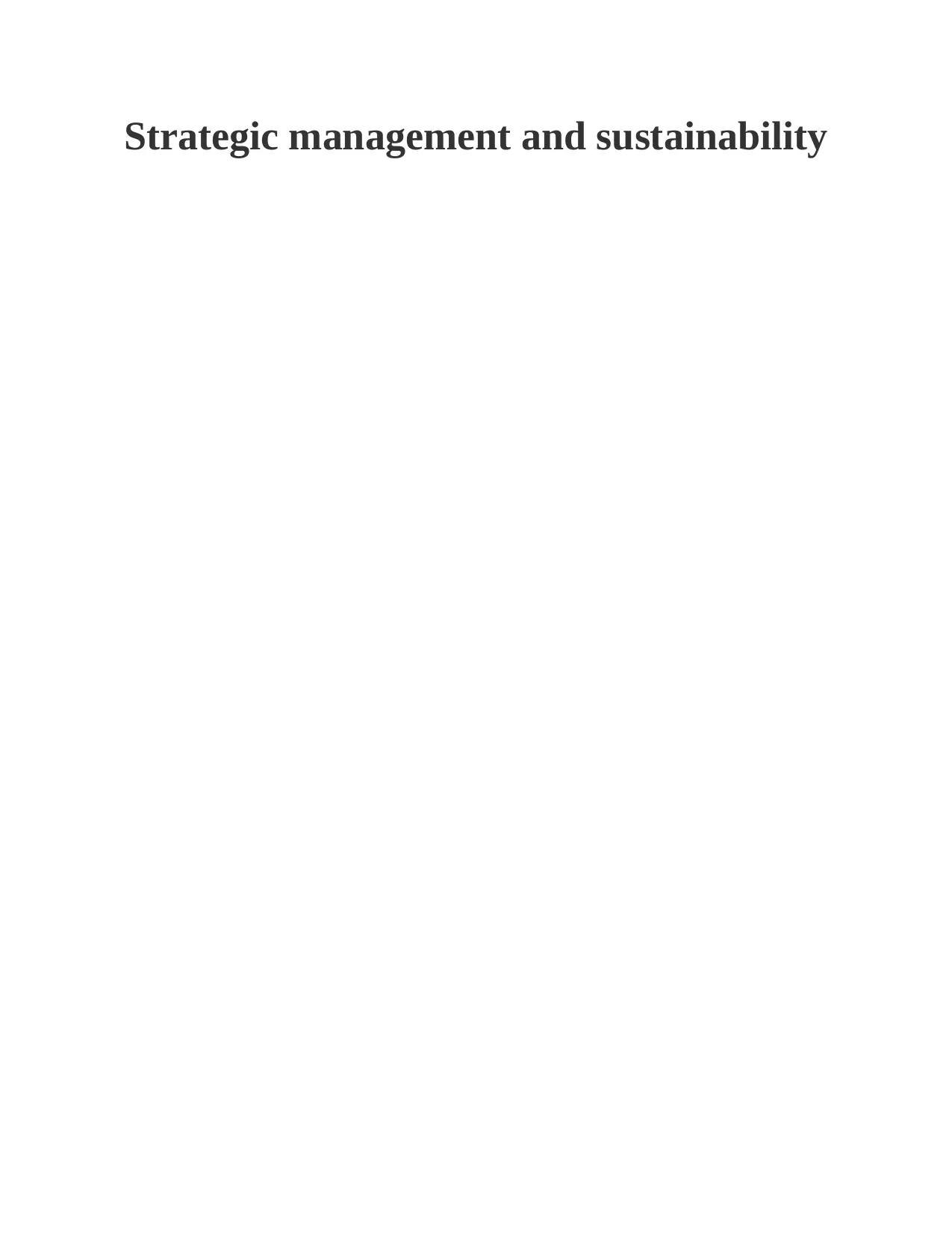
Strategic management and sustainability
Paraphrase This Document
Need a fresh take? Get an instant paraphrase of this document with our AI Paraphraser
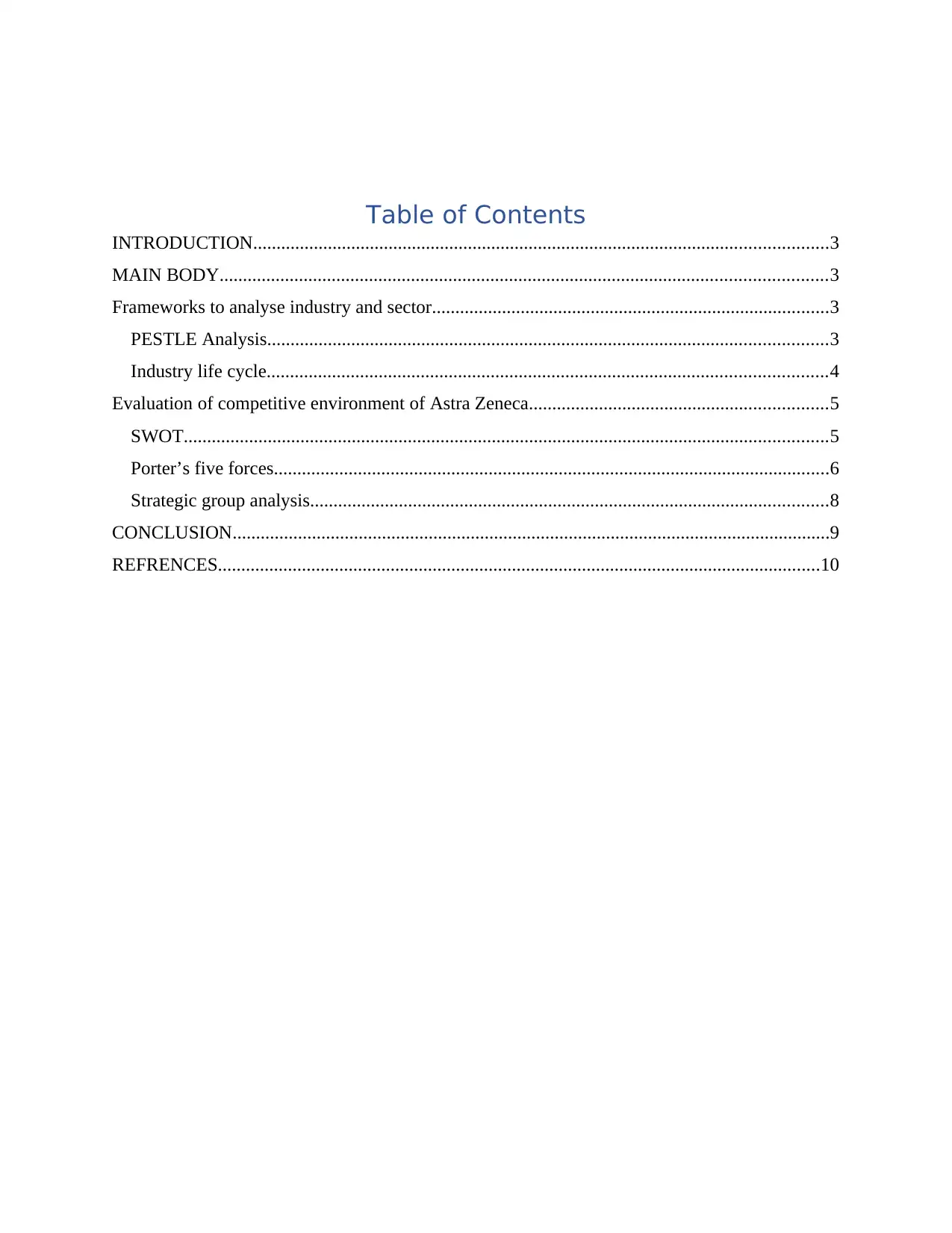
Table of Contents
INTRODUCTION...........................................................................................................................3
MAIN BODY..................................................................................................................................3
Frameworks to analyse industry and sector.....................................................................................3
PESTLE Analysis........................................................................................................................3
Industry life cycle........................................................................................................................4
Evaluation of competitive environment of Astra Zeneca................................................................5
SWOT..........................................................................................................................................5
Porter’s five forces.......................................................................................................................6
Strategic group analysis...............................................................................................................8
CONCLUSION................................................................................................................................9
REFRENCES.................................................................................................................................10
INTRODUCTION...........................................................................................................................3
MAIN BODY..................................................................................................................................3
Frameworks to analyse industry and sector.....................................................................................3
PESTLE Analysis........................................................................................................................3
Industry life cycle........................................................................................................................4
Evaluation of competitive environment of Astra Zeneca................................................................5
SWOT..........................................................................................................................................5
Porter’s five forces.......................................................................................................................6
Strategic group analysis...............................................................................................................8
CONCLUSION................................................................................................................................9
REFRENCES.................................................................................................................................10
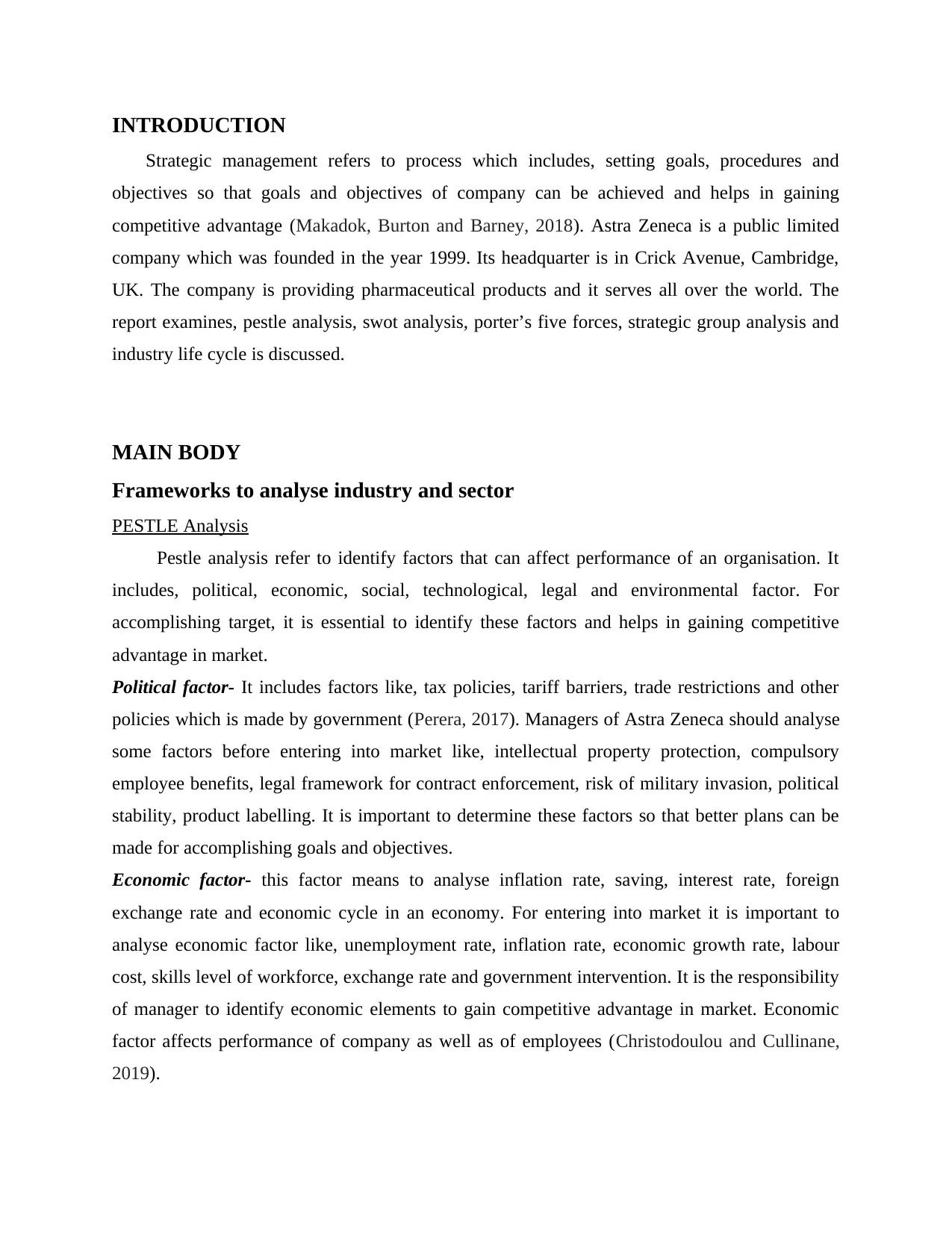
INTRODUCTION
Strategic management refers to process which includes, setting goals, procedures and
objectives so that goals and objectives of company can be achieved and helps in gaining
competitive advantage (Makadok, Burton and Barney, 2018). Astra Zeneca is a public limited
company which was founded in the year 1999. Its headquarter is in Crick Avenue, Cambridge,
UK. The company is providing pharmaceutical products and it serves all over the world. The
report examines, pestle analysis, swot analysis, porter’s five forces, strategic group analysis and
industry life cycle is discussed.
MAIN BODY
Frameworks to analyse industry and sector
PESTLE Analysis
Pestle analysis refer to identify factors that can affect performance of an organisation. It
includes, political, economic, social, technological, legal and environmental factor. For
accomplishing target, it is essential to identify these factors and helps in gaining competitive
advantage in market.
Political factor- It includes factors like, tax policies, tariff barriers, trade restrictions and other
policies which is made by government (Perera, 2017). Managers of Astra Zeneca should analyse
some factors before entering into market like, intellectual property protection, compulsory
employee benefits, legal framework for contract enforcement, risk of military invasion, political
stability, product labelling. It is important to determine these factors so that better plans can be
made for accomplishing goals and objectives.
Economic factor- this factor means to analyse inflation rate, saving, interest rate, foreign
exchange rate and economic cycle in an economy. For entering into market it is important to
analyse economic factor like, unemployment rate, inflation rate, economic growth rate, labour
cost, skills level of workforce, exchange rate and government intervention. It is the responsibility
of manager to identify economic elements to gain competitive advantage in market. Economic
factor affects performance of company as well as of employees (Christodoulou and Cullinane,
2019).
Strategic management refers to process which includes, setting goals, procedures and
objectives so that goals and objectives of company can be achieved and helps in gaining
competitive advantage (Makadok, Burton and Barney, 2018). Astra Zeneca is a public limited
company which was founded in the year 1999. Its headquarter is in Crick Avenue, Cambridge,
UK. The company is providing pharmaceutical products and it serves all over the world. The
report examines, pestle analysis, swot analysis, porter’s five forces, strategic group analysis and
industry life cycle is discussed.
MAIN BODY
Frameworks to analyse industry and sector
PESTLE Analysis
Pestle analysis refer to identify factors that can affect performance of an organisation. It
includes, political, economic, social, technological, legal and environmental factor. For
accomplishing target, it is essential to identify these factors and helps in gaining competitive
advantage in market.
Political factor- It includes factors like, tax policies, tariff barriers, trade restrictions and other
policies which is made by government (Perera, 2017). Managers of Astra Zeneca should analyse
some factors before entering into market like, intellectual property protection, compulsory
employee benefits, legal framework for contract enforcement, risk of military invasion, political
stability, product labelling. It is important to determine these factors so that better plans can be
made for accomplishing goals and objectives.
Economic factor- this factor means to analyse inflation rate, saving, interest rate, foreign
exchange rate and economic cycle in an economy. For entering into market it is important to
analyse economic factor like, unemployment rate, inflation rate, economic growth rate, labour
cost, skills level of workforce, exchange rate and government intervention. It is the responsibility
of manager to identify economic elements to gain competitive advantage in market. Economic
factor affects performance of company as well as of employees (Christodoulou and Cullinane,
2019).
⊘ This is a preview!⊘
Do you want full access?
Subscribe today to unlock all pages.

Trusted by 1+ million students worldwide
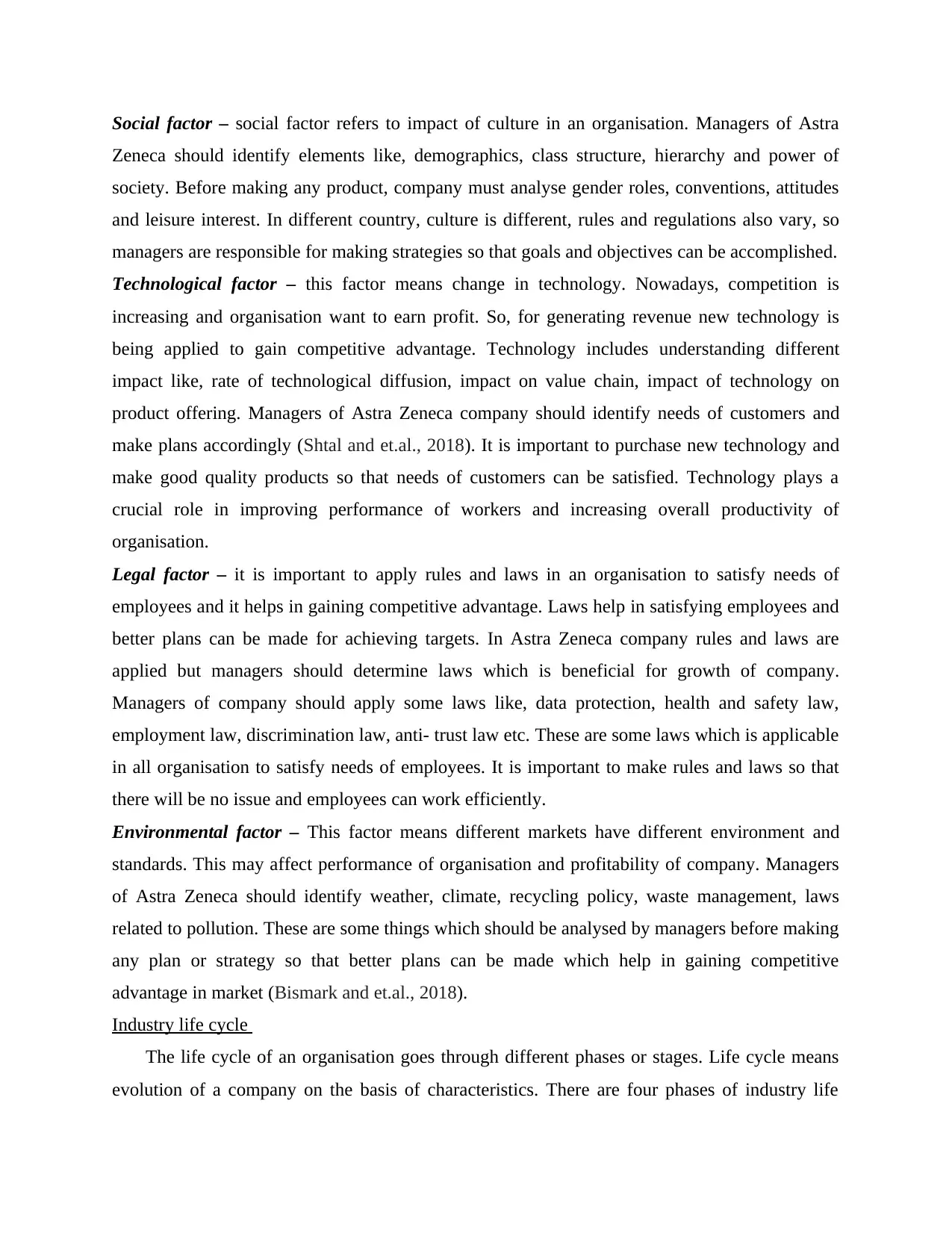
Social factor – social factor refers to impact of culture in an organisation. Managers of Astra
Zeneca should identify elements like, demographics, class structure, hierarchy and power of
society. Before making any product, company must analyse gender roles, conventions, attitudes
and leisure interest. In different country, culture is different, rules and regulations also vary, so
managers are responsible for making strategies so that goals and objectives can be accomplished.
Technological factor – this factor means change in technology. Nowadays, competition is
increasing and organisation want to earn profit. So, for generating revenue new technology is
being applied to gain competitive advantage. Technology includes understanding different
impact like, rate of technological diffusion, impact on value chain, impact of technology on
product offering. Managers of Astra Zeneca company should identify needs of customers and
make plans accordingly (Shtal and et.al., 2018). It is important to purchase new technology and
make good quality products so that needs of customers can be satisfied. Technology plays a
crucial role in improving performance of workers and increasing overall productivity of
organisation.
Legal factor – it is important to apply rules and laws in an organisation to satisfy needs of
employees and it helps in gaining competitive advantage. Laws help in satisfying employees and
better plans can be made for achieving targets. In Astra Zeneca company rules and laws are
applied but managers should determine laws which is beneficial for growth of company.
Managers of company should apply some laws like, data protection, health and safety law,
employment law, discrimination law, anti- trust law etc. These are some laws which is applicable
in all organisation to satisfy needs of employees. It is important to make rules and laws so that
there will be no issue and employees can work efficiently.
Environmental factor – This factor means different markets have different environment and
standards. This may affect performance of organisation and profitability of company. Managers
of Astra Zeneca should identify weather, climate, recycling policy, waste management, laws
related to pollution. These are some things which should be analysed by managers before making
any plan or strategy so that better plans can be made which help in gaining competitive
advantage in market (Bismark and et.al., 2018).
Industry life cycle
The life cycle of an organisation goes through different phases or stages. Life cycle means
evolution of a company on the basis of characteristics. There are four phases of industry life
Zeneca should identify elements like, demographics, class structure, hierarchy and power of
society. Before making any product, company must analyse gender roles, conventions, attitudes
and leisure interest. In different country, culture is different, rules and regulations also vary, so
managers are responsible for making strategies so that goals and objectives can be accomplished.
Technological factor – this factor means change in technology. Nowadays, competition is
increasing and organisation want to earn profit. So, for generating revenue new technology is
being applied to gain competitive advantage. Technology includes understanding different
impact like, rate of technological diffusion, impact on value chain, impact of technology on
product offering. Managers of Astra Zeneca company should identify needs of customers and
make plans accordingly (Shtal and et.al., 2018). It is important to purchase new technology and
make good quality products so that needs of customers can be satisfied. Technology plays a
crucial role in improving performance of workers and increasing overall productivity of
organisation.
Legal factor – it is important to apply rules and laws in an organisation to satisfy needs of
employees and it helps in gaining competitive advantage. Laws help in satisfying employees and
better plans can be made for achieving targets. In Astra Zeneca company rules and laws are
applied but managers should determine laws which is beneficial for growth of company.
Managers of company should apply some laws like, data protection, health and safety law,
employment law, discrimination law, anti- trust law etc. These are some laws which is applicable
in all organisation to satisfy needs of employees. It is important to make rules and laws so that
there will be no issue and employees can work efficiently.
Environmental factor – This factor means different markets have different environment and
standards. This may affect performance of organisation and profitability of company. Managers
of Astra Zeneca should identify weather, climate, recycling policy, waste management, laws
related to pollution. These are some things which should be analysed by managers before making
any plan or strategy so that better plans can be made which help in gaining competitive
advantage in market (Bismark and et.al., 2018).
Industry life cycle
The life cycle of an organisation goes through different phases or stages. Life cycle means
evolution of a company on the basis of characteristics. There are four phases of industry life
Paraphrase This Document
Need a fresh take? Get an instant paraphrase of this document with our AI Paraphraser
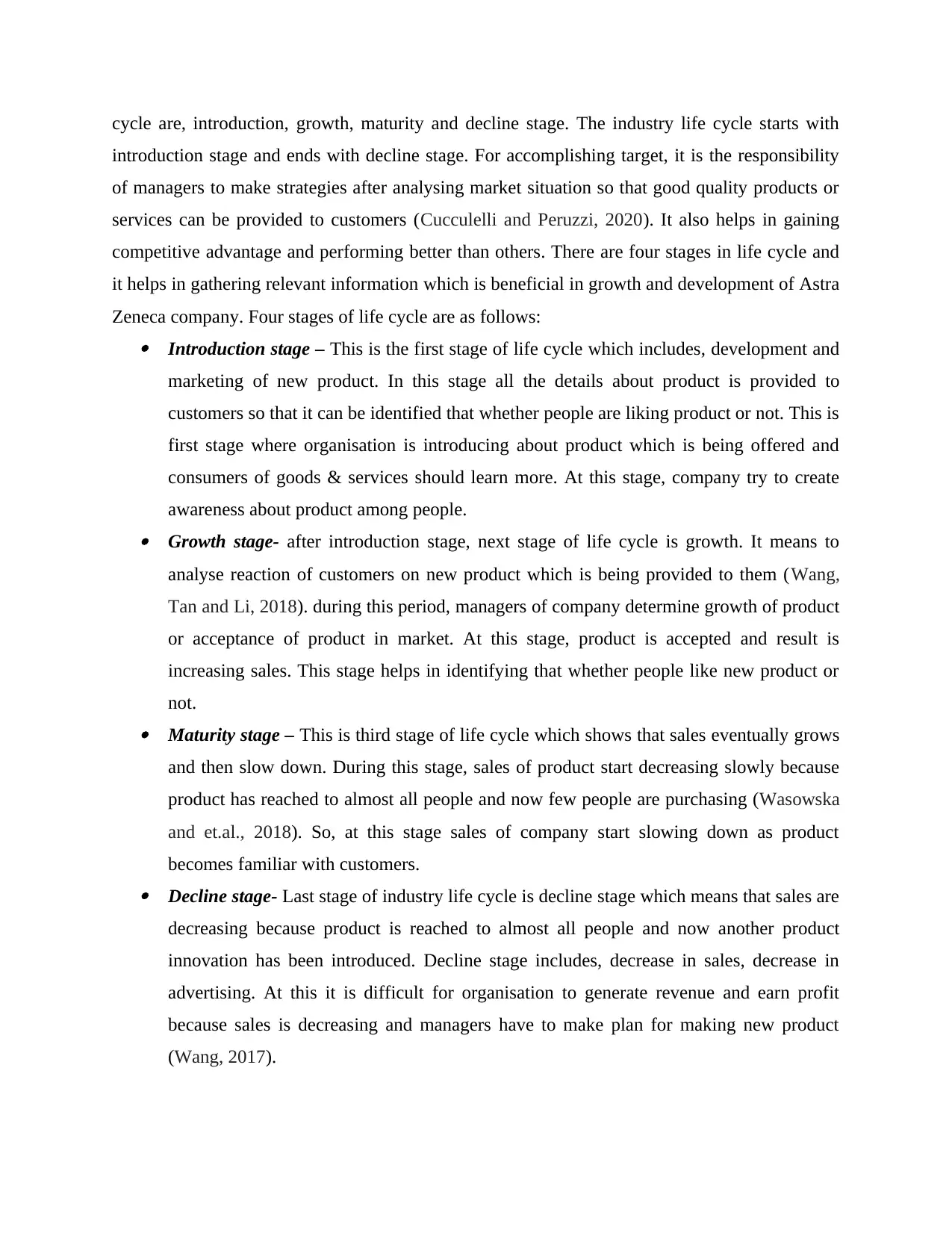
cycle are, introduction, growth, maturity and decline stage. The industry life cycle starts with
introduction stage and ends with decline stage. For accomplishing target, it is the responsibility
of managers to make strategies after analysing market situation so that good quality products or
services can be provided to customers (Cucculelli and Peruzzi, 2020). It also helps in gaining
competitive advantage and performing better than others. There are four stages in life cycle and
it helps in gathering relevant information which is beneficial in growth and development of Astra
Zeneca company. Four stages of life cycle are as follows: Introduction stage – This is the first stage of life cycle which includes, development and
marketing of new product. In this stage all the details about product is provided to
customers so that it can be identified that whether people are liking product or not. This is
first stage where organisation is introducing about product which is being offered and
consumers of goods & services should learn more. At this stage, company try to create
awareness about product among people. Growth stage- after introduction stage, next stage of life cycle is growth. It means to
analyse reaction of customers on new product which is being provided to them (Wang,
Tan and Li, 2018). during this period, managers of company determine growth of product
or acceptance of product in market. At this stage, product is accepted and result is
increasing sales. This stage helps in identifying that whether people like new product or
not. Maturity stage – This is third stage of life cycle which shows that sales eventually grows
and then slow down. During this stage, sales of product start decreasing slowly because
product has reached to almost all people and now few people are purchasing (Wasowska
and et.al., 2018). So, at this stage sales of company start slowing down as product
becomes familiar with customers. Decline stage- Last stage of industry life cycle is decline stage which means that sales are
decreasing because product is reached to almost all people and now another product
innovation has been introduced. Decline stage includes, decrease in sales, decrease in
advertising. At this it is difficult for organisation to generate revenue and earn profit
because sales is decreasing and managers have to make plan for making new product
(Wang, 2017).
introduction stage and ends with decline stage. For accomplishing target, it is the responsibility
of managers to make strategies after analysing market situation so that good quality products or
services can be provided to customers (Cucculelli and Peruzzi, 2020). It also helps in gaining
competitive advantage and performing better than others. There are four stages in life cycle and
it helps in gathering relevant information which is beneficial in growth and development of Astra
Zeneca company. Four stages of life cycle are as follows: Introduction stage – This is the first stage of life cycle which includes, development and
marketing of new product. In this stage all the details about product is provided to
customers so that it can be identified that whether people are liking product or not. This is
first stage where organisation is introducing about product which is being offered and
consumers of goods & services should learn more. At this stage, company try to create
awareness about product among people. Growth stage- after introduction stage, next stage of life cycle is growth. It means to
analyse reaction of customers on new product which is being provided to them (Wang,
Tan and Li, 2018). during this period, managers of company determine growth of product
or acceptance of product in market. At this stage, product is accepted and result is
increasing sales. This stage helps in identifying that whether people like new product or
not. Maturity stage – This is third stage of life cycle which shows that sales eventually grows
and then slow down. During this stage, sales of product start decreasing slowly because
product has reached to almost all people and now few people are purchasing (Wasowska
and et.al., 2018). So, at this stage sales of company start slowing down as product
becomes familiar with customers. Decline stage- Last stage of industry life cycle is decline stage which means that sales are
decreasing because product is reached to almost all people and now another product
innovation has been introduced. Decline stage includes, decrease in sales, decrease in
advertising. At this it is difficult for organisation to generate revenue and earn profit
because sales is decreasing and managers have to make plan for making new product
(Wang, 2017).
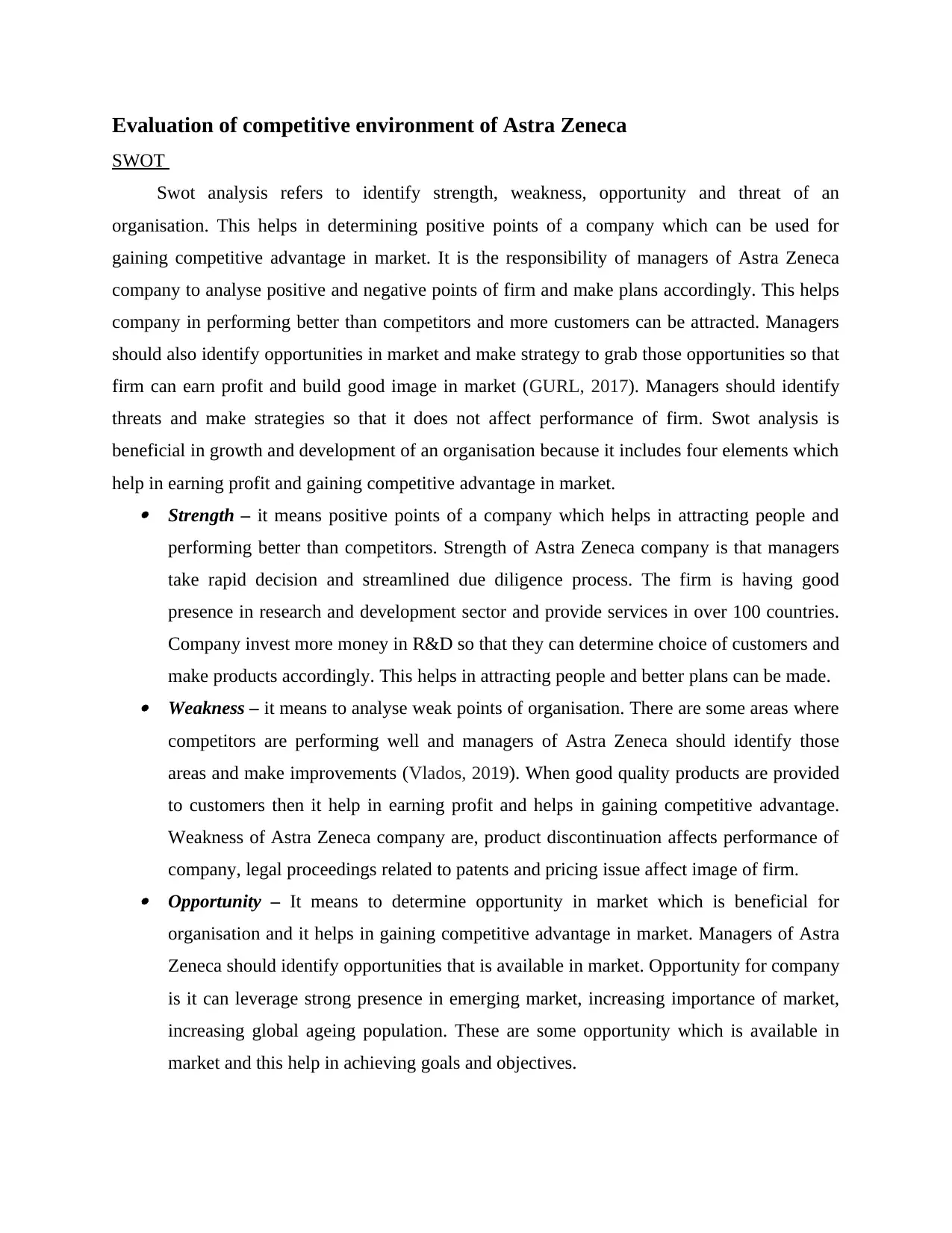
Evaluation of competitive environment of Astra Zeneca
SWOT
Swot analysis refers to identify strength, weakness, opportunity and threat of an
organisation. This helps in determining positive points of a company which can be used for
gaining competitive advantage in market. It is the responsibility of managers of Astra Zeneca
company to analyse positive and negative points of firm and make plans accordingly. This helps
company in performing better than competitors and more customers can be attracted. Managers
should also identify opportunities in market and make strategy to grab those opportunities so that
firm can earn profit and build good image in market (GURL, 2017). Managers should identify
threats and make strategies so that it does not affect performance of firm. Swot analysis is
beneficial in growth and development of an organisation because it includes four elements which
help in earning profit and gaining competitive advantage in market. Strength – it means positive points of a company which helps in attracting people and
performing better than competitors. Strength of Astra Zeneca company is that managers
take rapid decision and streamlined due diligence process. The firm is having good
presence in research and development sector and provide services in over 100 countries.
Company invest more money in R&D so that they can determine choice of customers and
make products accordingly. This helps in attracting people and better plans can be made. Weakness – it means to analyse weak points of organisation. There are some areas where
competitors are performing well and managers of Astra Zeneca should identify those
areas and make improvements (Vlados, 2019). When good quality products are provided
to customers then it help in earning profit and helps in gaining competitive advantage.
Weakness of Astra Zeneca company are, product discontinuation affects performance of
company, legal proceedings related to patents and pricing issue affect image of firm. Opportunity – It means to determine opportunity in market which is beneficial for
organisation and it helps in gaining competitive advantage in market. Managers of Astra
Zeneca should identify opportunities that is available in market. Opportunity for company
is it can leverage strong presence in emerging market, increasing importance of market,
increasing global ageing population. These are some opportunity which is available in
market and this help in achieving goals and objectives.
SWOT
Swot analysis refers to identify strength, weakness, opportunity and threat of an
organisation. This helps in determining positive points of a company which can be used for
gaining competitive advantage in market. It is the responsibility of managers of Astra Zeneca
company to analyse positive and negative points of firm and make plans accordingly. This helps
company in performing better than competitors and more customers can be attracted. Managers
should also identify opportunities in market and make strategy to grab those opportunities so that
firm can earn profit and build good image in market (GURL, 2017). Managers should identify
threats and make strategies so that it does not affect performance of firm. Swot analysis is
beneficial in growth and development of an organisation because it includes four elements which
help in earning profit and gaining competitive advantage in market. Strength – it means positive points of a company which helps in attracting people and
performing better than competitors. Strength of Astra Zeneca company is that managers
take rapid decision and streamlined due diligence process. The firm is having good
presence in research and development sector and provide services in over 100 countries.
Company invest more money in R&D so that they can determine choice of customers and
make products accordingly. This helps in attracting people and better plans can be made. Weakness – it means to analyse weak points of organisation. There are some areas where
competitors are performing well and managers of Astra Zeneca should identify those
areas and make improvements (Vlados, 2019). When good quality products are provided
to customers then it help in earning profit and helps in gaining competitive advantage.
Weakness of Astra Zeneca company are, product discontinuation affects performance of
company, legal proceedings related to patents and pricing issue affect image of firm. Opportunity – It means to determine opportunity in market which is beneficial for
organisation and it helps in gaining competitive advantage in market. Managers of Astra
Zeneca should identify opportunities that is available in market. Opportunity for company
is it can leverage strong presence in emerging market, increasing importance of market,
increasing global ageing population. These are some opportunity which is available in
market and this help in achieving goals and objectives.
⊘ This is a preview!⊘
Do you want full access?
Subscribe today to unlock all pages.

Trusted by 1+ million students worldwide
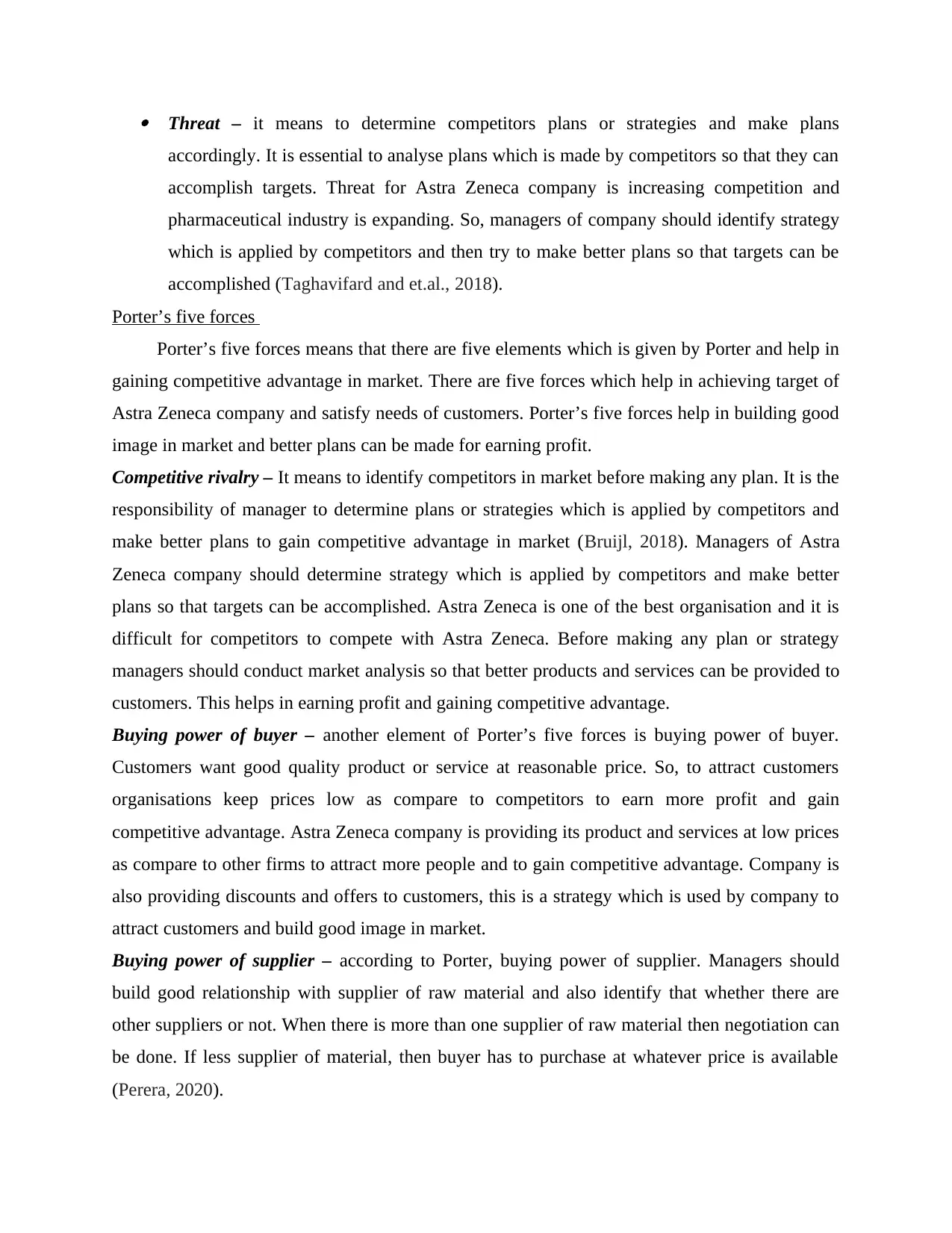
Threat – it means to determine competitors plans or strategies and make plans
accordingly. It is essential to analyse plans which is made by competitors so that they can
accomplish targets. Threat for Astra Zeneca company is increasing competition and
pharmaceutical industry is expanding. So, managers of company should identify strategy
which is applied by competitors and then try to make better plans so that targets can be
accomplished (Taghavifard and et.al., 2018).
Porter’s five forces
Porter’s five forces means that there are five elements which is given by Porter and help in
gaining competitive advantage in market. There are five forces which help in achieving target of
Astra Zeneca company and satisfy needs of customers. Porter’s five forces help in building good
image in market and better plans can be made for earning profit.
Competitive rivalry – It means to identify competitors in market before making any plan. It is the
responsibility of manager to determine plans or strategies which is applied by competitors and
make better plans to gain competitive advantage in market (Bruijl, 2018). Managers of Astra
Zeneca company should determine strategy which is applied by competitors and make better
plans so that targets can be accomplished. Astra Zeneca is one of the best organisation and it is
difficult for competitors to compete with Astra Zeneca. Before making any plan or strategy
managers should conduct market analysis so that better products and services can be provided to
customers. This helps in earning profit and gaining competitive advantage.
Buying power of buyer – another element of Porter’s five forces is buying power of buyer.
Customers want good quality product or service at reasonable price. So, to attract customers
organisations keep prices low as compare to competitors to earn more profit and gain
competitive advantage. Astra Zeneca company is providing its product and services at low prices
as compare to other firms to attract more people and to gain competitive advantage. Company is
also providing discounts and offers to customers, this is a strategy which is used by company to
attract customers and build good image in market.
Buying power of supplier – according to Porter, buying power of supplier. Managers should
build good relationship with supplier of raw material and also identify that whether there are
other suppliers or not. When there is more than one supplier of raw material then negotiation can
be done. If less supplier of material, then buyer has to purchase at whatever price is available
(Perera, 2020).
accordingly. It is essential to analyse plans which is made by competitors so that they can
accomplish targets. Threat for Astra Zeneca company is increasing competition and
pharmaceutical industry is expanding. So, managers of company should identify strategy
which is applied by competitors and then try to make better plans so that targets can be
accomplished (Taghavifard and et.al., 2018).
Porter’s five forces
Porter’s five forces means that there are five elements which is given by Porter and help in
gaining competitive advantage in market. There are five forces which help in achieving target of
Astra Zeneca company and satisfy needs of customers. Porter’s five forces help in building good
image in market and better plans can be made for earning profit.
Competitive rivalry – It means to identify competitors in market before making any plan. It is the
responsibility of manager to determine plans or strategies which is applied by competitors and
make better plans to gain competitive advantage in market (Bruijl, 2018). Managers of Astra
Zeneca company should determine strategy which is applied by competitors and make better
plans so that targets can be accomplished. Astra Zeneca is one of the best organisation and it is
difficult for competitors to compete with Astra Zeneca. Before making any plan or strategy
managers should conduct market analysis so that better products and services can be provided to
customers. This helps in earning profit and gaining competitive advantage.
Buying power of buyer – another element of Porter’s five forces is buying power of buyer.
Customers want good quality product or service at reasonable price. So, to attract customers
organisations keep prices low as compare to competitors to earn more profit and gain
competitive advantage. Astra Zeneca company is providing its product and services at low prices
as compare to other firms to attract more people and to gain competitive advantage. Company is
also providing discounts and offers to customers, this is a strategy which is used by company to
attract customers and build good image in market.
Buying power of supplier – according to Porter, buying power of supplier. Managers should
build good relationship with supplier of raw material and also identify that whether there are
other suppliers or not. When there is more than one supplier of raw material then negotiation can
be done. If less supplier of material, then buyer has to purchase at whatever price is available
(Perera, 2020).
Paraphrase This Document
Need a fresh take? Get an instant paraphrase of this document with our AI Paraphraser
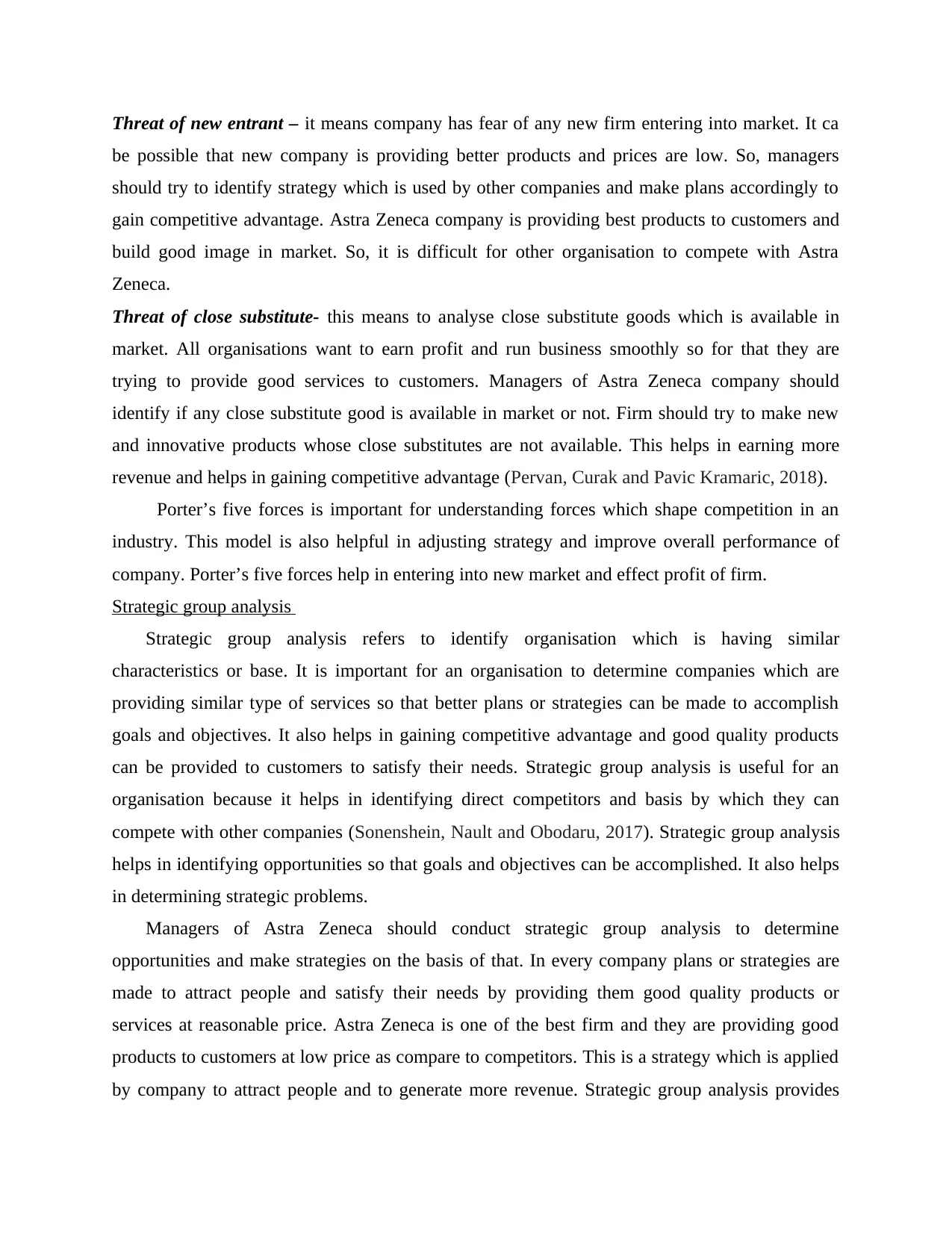
Threat of new entrant – it means company has fear of any new firm entering into market. It ca
be possible that new company is providing better products and prices are low. So, managers
should try to identify strategy which is used by other companies and make plans accordingly to
gain competitive advantage. Astra Zeneca company is providing best products to customers and
build good image in market. So, it is difficult for other organisation to compete with Astra
Zeneca.
Threat of close substitute- this means to analyse close substitute goods which is available in
market. All organisations want to earn profit and run business smoothly so for that they are
trying to provide good services to customers. Managers of Astra Zeneca company should
identify if any close substitute good is available in market or not. Firm should try to make new
and innovative products whose close substitutes are not available. This helps in earning more
revenue and helps in gaining competitive advantage (Pervan, Curak and Pavic Kramaric, 2018).
Porter’s five forces is important for understanding forces which shape competition in an
industry. This model is also helpful in adjusting strategy and improve overall performance of
company. Porter’s five forces help in entering into new market and effect profit of firm.
Strategic group analysis
Strategic group analysis refers to identify organisation which is having similar
characteristics or base. It is important for an organisation to determine companies which are
providing similar type of services so that better plans or strategies can be made to accomplish
goals and objectives. It also helps in gaining competitive advantage and good quality products
can be provided to customers to satisfy their needs. Strategic group analysis is useful for an
organisation because it helps in identifying direct competitors and basis by which they can
compete with other companies (Sonenshein, Nault and Obodaru, 2017). Strategic group analysis
helps in identifying opportunities so that goals and objectives can be accomplished. It also helps
in determining strategic problems.
Managers of Astra Zeneca should conduct strategic group analysis to determine
opportunities and make strategies on the basis of that. In every company plans or strategies are
made to attract people and satisfy their needs by providing them good quality products or
services at reasonable price. Astra Zeneca is one of the best firm and they are providing good
products to customers at low price as compare to competitors. This is a strategy which is applied
by company to attract people and to generate more revenue. Strategic group analysis provides
be possible that new company is providing better products and prices are low. So, managers
should try to identify strategy which is used by other companies and make plans accordingly to
gain competitive advantage. Astra Zeneca company is providing best products to customers and
build good image in market. So, it is difficult for other organisation to compete with Astra
Zeneca.
Threat of close substitute- this means to analyse close substitute goods which is available in
market. All organisations want to earn profit and run business smoothly so for that they are
trying to provide good services to customers. Managers of Astra Zeneca company should
identify if any close substitute good is available in market or not. Firm should try to make new
and innovative products whose close substitutes are not available. This helps in earning more
revenue and helps in gaining competitive advantage (Pervan, Curak and Pavic Kramaric, 2018).
Porter’s five forces is important for understanding forces which shape competition in an
industry. This model is also helpful in adjusting strategy and improve overall performance of
company. Porter’s five forces help in entering into new market and effect profit of firm.
Strategic group analysis
Strategic group analysis refers to identify organisation which is having similar
characteristics or base. It is important for an organisation to determine companies which are
providing similar type of services so that better plans or strategies can be made to accomplish
goals and objectives. It also helps in gaining competitive advantage and good quality products
can be provided to customers to satisfy their needs. Strategic group analysis is useful for an
organisation because it helps in identifying direct competitors and basis by which they can
compete with other companies (Sonenshein, Nault and Obodaru, 2017). Strategic group analysis
helps in identifying opportunities so that goals and objectives can be accomplished. It also helps
in determining strategic problems.
Managers of Astra Zeneca should conduct strategic group analysis to determine
opportunities and make strategies on the basis of that. In every company plans or strategies are
made to attract people and satisfy their needs by providing them good quality products or
services at reasonable price. Astra Zeneca is one of the best firm and they are providing good
products to customers at low price as compare to competitors. This is a strategy which is applied
by company to attract people and to generate more revenue. Strategic group analysis provides
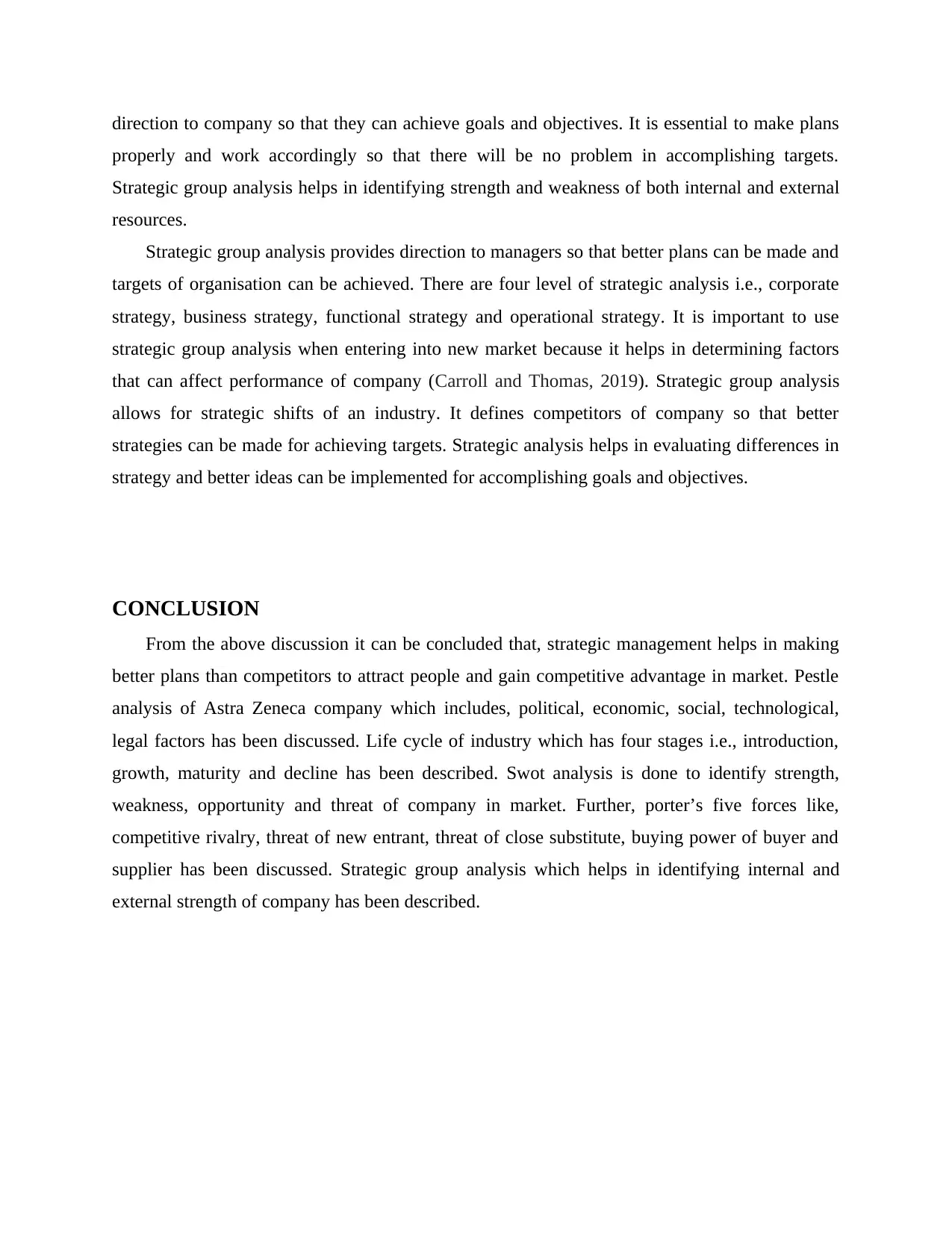
direction to company so that they can achieve goals and objectives. It is essential to make plans
properly and work accordingly so that there will be no problem in accomplishing targets.
Strategic group analysis helps in identifying strength and weakness of both internal and external
resources.
Strategic group analysis provides direction to managers so that better plans can be made and
targets of organisation can be achieved. There are four level of strategic analysis i.e., corporate
strategy, business strategy, functional strategy and operational strategy. It is important to use
strategic group analysis when entering into new market because it helps in determining factors
that can affect performance of company (Carroll and Thomas, 2019). Strategic group analysis
allows for strategic shifts of an industry. It defines competitors of company so that better
strategies can be made for achieving targets. Strategic analysis helps in evaluating differences in
strategy and better ideas can be implemented for accomplishing goals and objectives.
CONCLUSION
From the above discussion it can be concluded that, strategic management helps in making
better plans than competitors to attract people and gain competitive advantage in market. Pestle
analysis of Astra Zeneca company which includes, political, economic, social, technological,
legal factors has been discussed. Life cycle of industry which has four stages i.e., introduction,
growth, maturity and decline has been described. Swot analysis is done to identify strength,
weakness, opportunity and threat of company in market. Further, porter’s five forces like,
competitive rivalry, threat of new entrant, threat of close substitute, buying power of buyer and
supplier has been discussed. Strategic group analysis which helps in identifying internal and
external strength of company has been described.
properly and work accordingly so that there will be no problem in accomplishing targets.
Strategic group analysis helps in identifying strength and weakness of both internal and external
resources.
Strategic group analysis provides direction to managers so that better plans can be made and
targets of organisation can be achieved. There are four level of strategic analysis i.e., corporate
strategy, business strategy, functional strategy and operational strategy. It is important to use
strategic group analysis when entering into new market because it helps in determining factors
that can affect performance of company (Carroll and Thomas, 2019). Strategic group analysis
allows for strategic shifts of an industry. It defines competitors of company so that better
strategies can be made for achieving targets. Strategic analysis helps in evaluating differences in
strategy and better ideas can be implemented for accomplishing goals and objectives.
CONCLUSION
From the above discussion it can be concluded that, strategic management helps in making
better plans than competitors to attract people and gain competitive advantage in market. Pestle
analysis of Astra Zeneca company which includes, political, economic, social, technological,
legal factors has been discussed. Life cycle of industry which has four stages i.e., introduction,
growth, maturity and decline has been described. Swot analysis is done to identify strength,
weakness, opportunity and threat of company in market. Further, porter’s five forces like,
competitive rivalry, threat of new entrant, threat of close substitute, buying power of buyer and
supplier has been discussed. Strategic group analysis which helps in identifying internal and
external strength of company has been described.
⊘ This is a preview!⊘
Do you want full access?
Subscribe today to unlock all pages.

Trusted by 1+ million students worldwide
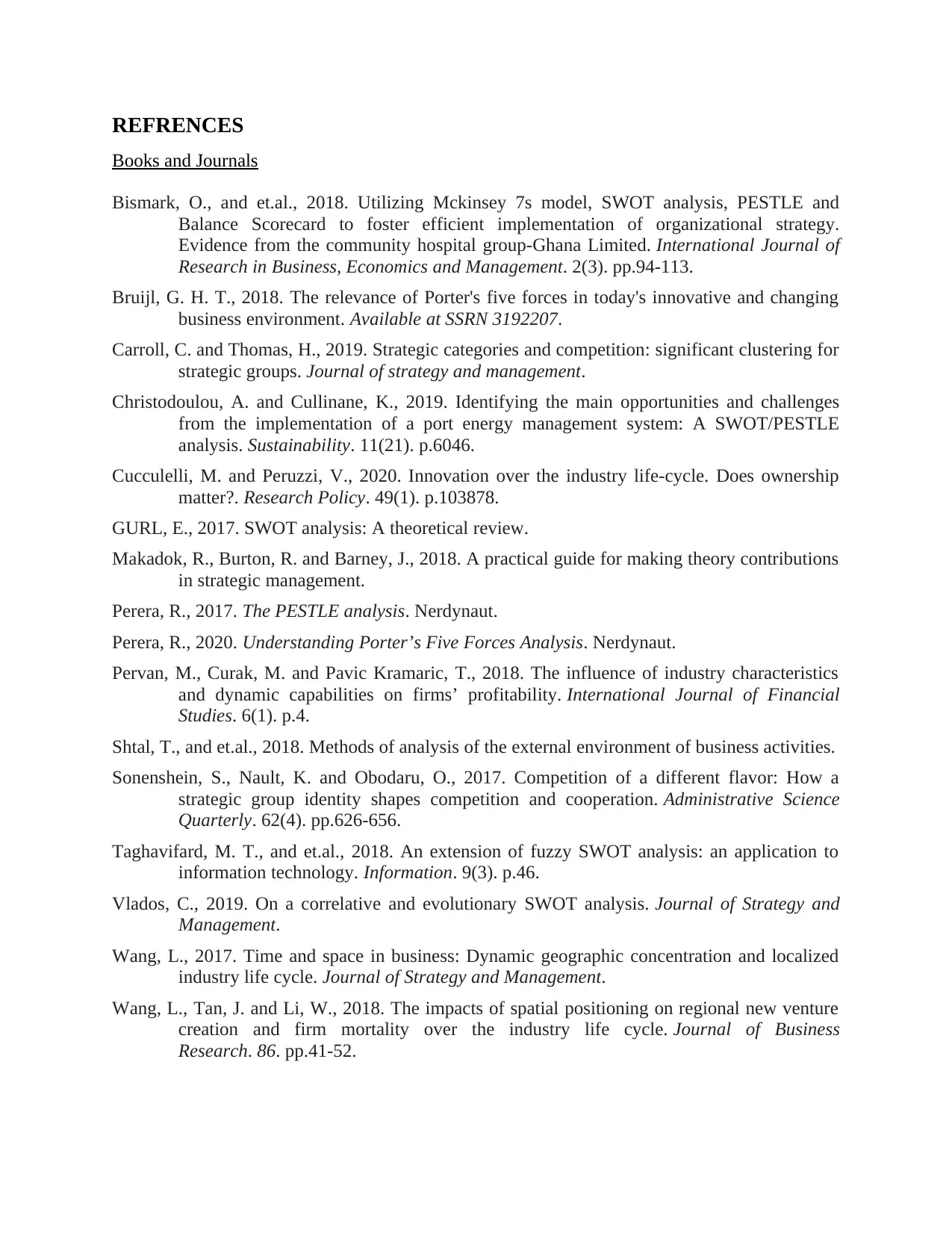
REFRENCES
Books and Journals
Bismark, O., and et.al., 2018. Utilizing Mckinsey 7s model, SWOT analysis, PESTLE and
Balance Scorecard to foster efficient implementation of organizational strategy.
Evidence from the community hospital group-Ghana Limited. International Journal of
Research in Business, Economics and Management. 2(3). pp.94-113.
Bruijl, G. H. T., 2018. The relevance of Porter's five forces in today's innovative and changing
business environment. Available at SSRN 3192207.
Carroll, C. and Thomas, H., 2019. Strategic categories and competition: significant clustering for
strategic groups. Journal of strategy and management.
Christodoulou, A. and Cullinane, K., 2019. Identifying the main opportunities and challenges
from the implementation of a port energy management system: A SWOT/PESTLE
analysis. Sustainability. 11(21). p.6046.
Cucculelli, M. and Peruzzi, V., 2020. Innovation over the industry life-cycle. Does ownership
matter?. Research Policy. 49(1). p.103878.
GURL, E., 2017. SWOT analysis: A theoretical review.
Makadok, R., Burton, R. and Barney, J., 2018. A practical guide for making theory contributions
in strategic management.
Perera, R., 2017. The PESTLE analysis. Nerdynaut.
Perera, R., 2020. Understanding Porter’s Five Forces Analysis. Nerdynaut.
Pervan, M., Curak, M. and Pavic Kramaric, T., 2018. The influence of industry characteristics
and dynamic capabilities on firms’ profitability. International Journal of Financial
Studies. 6(1). p.4.
Shtal, T., and et.al., 2018. Methods of analysis of the external environment of business activities.
Sonenshein, S., Nault, K. and Obodaru, O., 2017. Competition of a different flavor: How a
strategic group identity shapes competition and cooperation. Administrative Science
Quarterly. 62(4). pp.626-656.
Taghavifard, M. T., and et.al., 2018. An extension of fuzzy SWOT analysis: an application to
information technology. Information. 9(3). p.46.
Vlados, C., 2019. On a correlative and evolutionary SWOT analysis. Journal of Strategy and
Management.
Wang, L., 2017. Time and space in business: Dynamic geographic concentration and localized
industry life cycle. Journal of Strategy and Management.
Wang, L., Tan, J. and Li, W., 2018. The impacts of spatial positioning on regional new venture
creation and firm mortality over the industry life cycle. Journal of Business
Research. 86. pp.41-52.
Books and Journals
Bismark, O., and et.al., 2018. Utilizing Mckinsey 7s model, SWOT analysis, PESTLE and
Balance Scorecard to foster efficient implementation of organizational strategy.
Evidence from the community hospital group-Ghana Limited. International Journal of
Research in Business, Economics and Management. 2(3). pp.94-113.
Bruijl, G. H. T., 2018. The relevance of Porter's five forces in today's innovative and changing
business environment. Available at SSRN 3192207.
Carroll, C. and Thomas, H., 2019. Strategic categories and competition: significant clustering for
strategic groups. Journal of strategy and management.
Christodoulou, A. and Cullinane, K., 2019. Identifying the main opportunities and challenges
from the implementation of a port energy management system: A SWOT/PESTLE
analysis. Sustainability. 11(21). p.6046.
Cucculelli, M. and Peruzzi, V., 2020. Innovation over the industry life-cycle. Does ownership
matter?. Research Policy. 49(1). p.103878.
GURL, E., 2017. SWOT analysis: A theoretical review.
Makadok, R., Burton, R. and Barney, J., 2018. A practical guide for making theory contributions
in strategic management.
Perera, R., 2017. The PESTLE analysis. Nerdynaut.
Perera, R., 2020. Understanding Porter’s Five Forces Analysis. Nerdynaut.
Pervan, M., Curak, M. and Pavic Kramaric, T., 2018. The influence of industry characteristics
and dynamic capabilities on firms’ profitability. International Journal of Financial
Studies. 6(1). p.4.
Shtal, T., and et.al., 2018. Methods of analysis of the external environment of business activities.
Sonenshein, S., Nault, K. and Obodaru, O., 2017. Competition of a different flavor: How a
strategic group identity shapes competition and cooperation. Administrative Science
Quarterly. 62(4). pp.626-656.
Taghavifard, M. T., and et.al., 2018. An extension of fuzzy SWOT analysis: an application to
information technology. Information. 9(3). p.46.
Vlados, C., 2019. On a correlative and evolutionary SWOT analysis. Journal of Strategy and
Management.
Wang, L., 2017. Time and space in business: Dynamic geographic concentration and localized
industry life cycle. Journal of Strategy and Management.
Wang, L., Tan, J. and Li, W., 2018. The impacts of spatial positioning on regional new venture
creation and firm mortality over the industry life cycle. Journal of Business
Research. 86. pp.41-52.
Paraphrase This Document
Need a fresh take? Get an instant paraphrase of this document with our AI Paraphraser
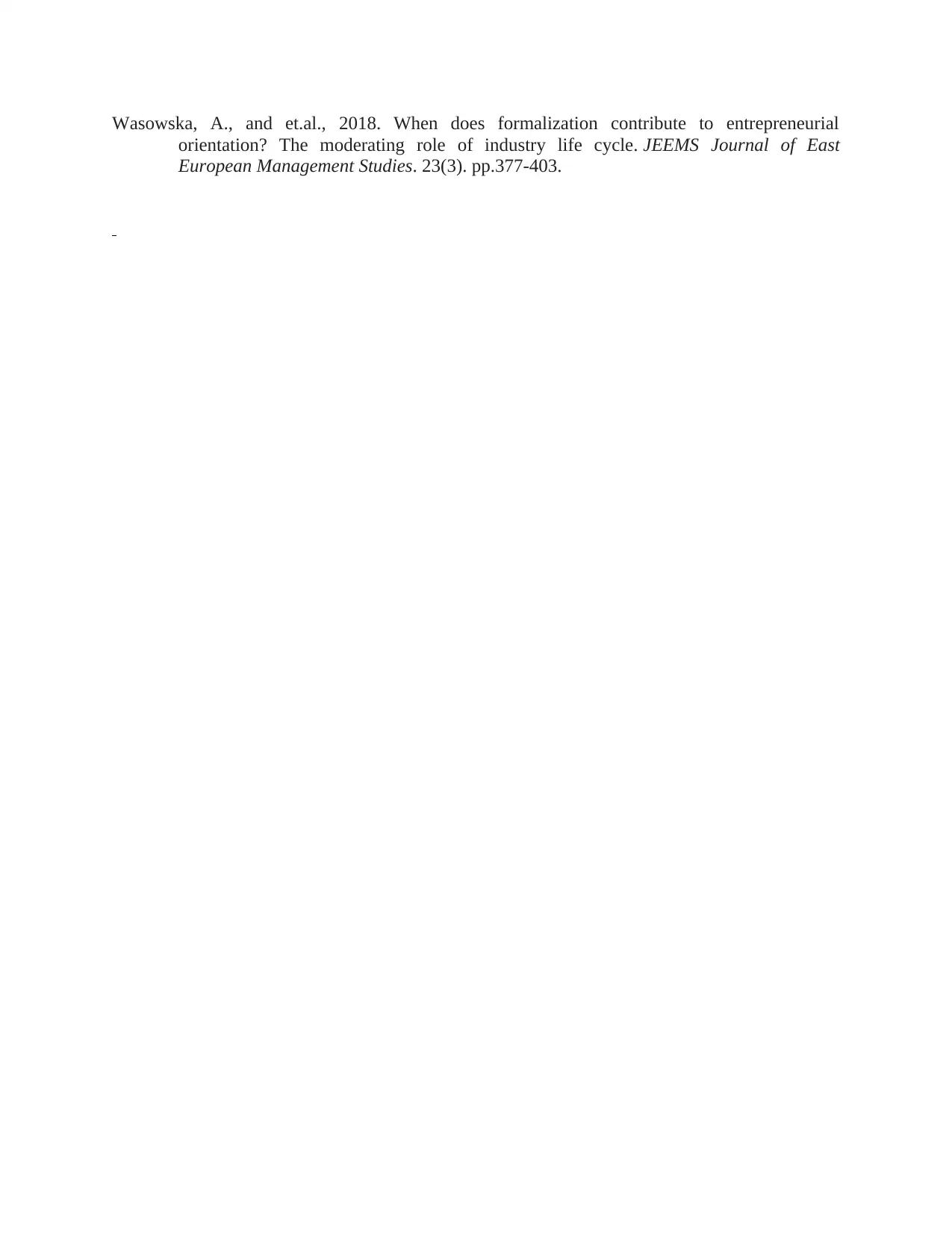
Wasowska, A., and et.al., 2018. When does formalization contribute to entrepreneurial
orientation? The moderating role of industry life cycle. JEEMS Journal of East
European Management Studies. 23(3). pp.377-403.
orientation? The moderating role of industry life cycle. JEEMS Journal of East
European Management Studies. 23(3). pp.377-403.
1 out of 11
Related Documents
Your All-in-One AI-Powered Toolkit for Academic Success.
+13062052269
info@desklib.com
Available 24*7 on WhatsApp / Email
![[object Object]](/_next/static/media/star-bottom.7253800d.svg)
Unlock your academic potential
Copyright © 2020–2025 A2Z Services. All Rights Reserved. Developed and managed by ZUCOL.





